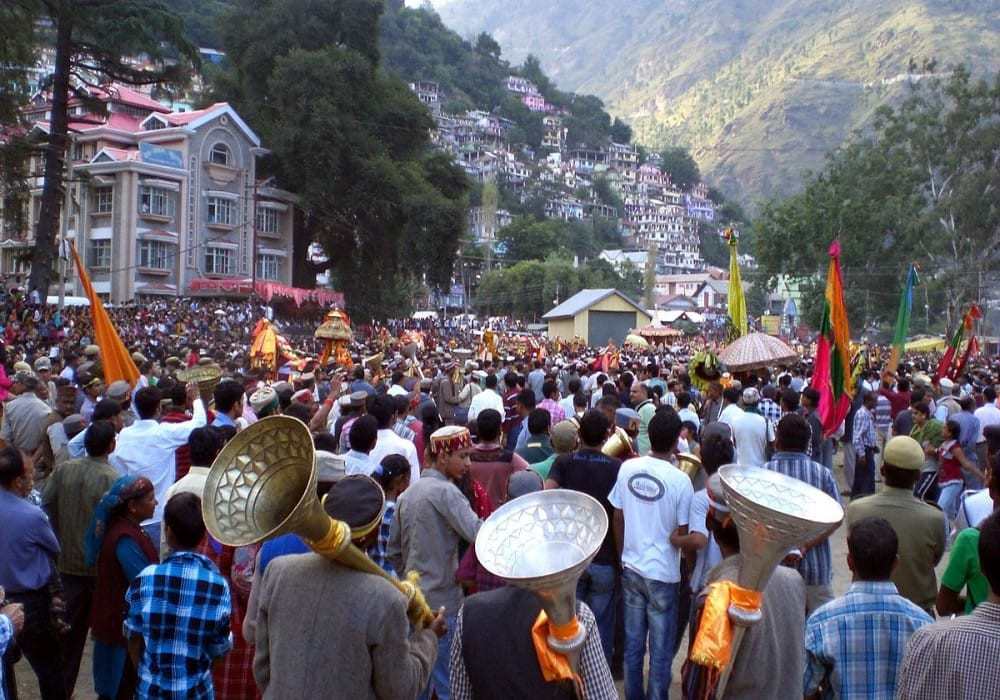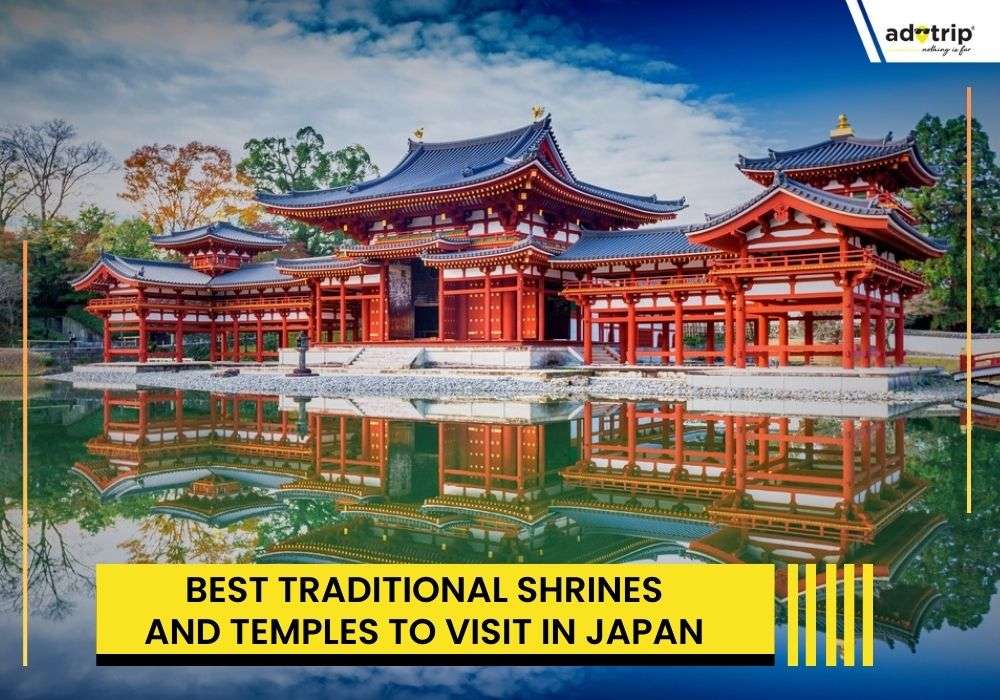.jpg)
Last Updated At: 30-May-2024
15 Famous Festivals Of Japan You Must Experience In 2024
Immerse yourself in the enchanting tapestry of vibrant festivals of Japan, where ancient traditions blend harmoniously with modern exuberance. With a rich cultural legacy spanning centuries, these jubilant gatherings offer a kaleidoscope of colours, rhythms, and rituals that bewitch both locals and visitors alike. From the mesmerising spectacle of cherry blossoms adorning spring's Hanami festivals to the resounding beats of thundering taiko drums during summer's lively Obon celebrations, Japan's festivals encapsulate a profound connection to nature and the spirit world. As autumn's fiery foliage paints the landscape, the captivating allure of traditional dance and elaborately crafted floats illuminates the exhilarating Matsuri festivals. Embrace the warmth of hospitality, savour delectable delights, and bask in the unifying spirit that permeates these culturally captivating events in the Land of the Rising Sun.
List Of 15 Popular Festivals In Japan
Are you ready to explore these spellbinding festivals in Japan? Here is our well-curated list, promising an unforgettable journey into the heart of Japanese culture and festivities.
- Sapporo Snow Festival - Snow Sculptures Galore
- Cherry Blossom Festival - Blossoms Paint Spring
- Kishiwada Danjiri Matsuri - Vibrant Float Festival
- Golden Week - National Holiday Extravaganza
- Aoi Matsuri - Colourful Kyoto Procession
- Takayama Matsuri - Historical Celebration
- Gion Matsuri - Kyoto’s Lively Fiesta
- Obon Festival - Honouring Ancestral Spirits
- Nebuta Matsuri - Spectacular Illuminated Floats
- Jidai Matsuri - Journey through Time
- Kanamara Matsuri - Celebrating Fertility Bravely
- Awa Odori - Energetic Dance Spectacle
- Karatsu Kunchi - Enchanting Autumn Festival
- Yuki Matsuri - Snowy Wonderland Festival
- Tanabata Festival - Wishing on Stars
1. Sapporo Snow Festival | Snow Sculptures Galore
The Sapporo Snow Festival is a world-famous winter event held annually in Sapporo, Hokkaido, Japan. It showcases incredible Japanese cultural celebrations where snow and ice sculptures created by talented artists from around the world. The festival usually takes place in February and lasts for about a week. The main venue is Odori Park, where massive snow sculptures, some reaching up to 15 metres in height, are displayed along the park's 1.5-kilometer stretch. Another venue is the Susukino Ice Festival, featuring intricately carved ice sculptures and ice bars. Visitors can enjoy various activities, including snowboarding, snow tubing, and sampling delicious local food and drinks.
- Month. February
- Location. Sapporo, Hokkaido
2. Cherry Blossom Festival | Blossoms Paint Spring
The Cherry Blossom Festival in Japan, also known as Hanami, is a cherished tradition that celebrates the blooming of cherry blossoms, or sakura. These pink beauties typically occurs in late March to early April, depending on the region and weather conditions. People gather in parks, gardens, and along riversides to admire the breathtaking beauty of the delicate pink and white flowers. The most popular cherry blossom spots include Tokyo's Ueno Park, Kyoto's Maruyama Park, and Osaka Castle Park. Hanami parties are held under the blooming trees, where friends, families, and coworkers enjoy picnics, drinks, and music. The festival represents the ephemeral nature of life and is a symbol of renewal and the arrival of spring. It's a time of joy, reflection, and appreciation of nature's fleeting beauty.
- Month. Late March to early April
- Location. Various locations
3. Kishiwada Danjiri Matsuri | Vibrant Float Festival
The Kishiwada Danjiri Matsuri is a vibrant and exhilarating festival of Japan celebrated with immense zeal 7 fervour. Known as one of the most energetic festivals in the country, it takes place on September 14th-15th each year. The highlight of the festival is the danjiri, a large wooden float adorned with intricate carvings and colourful decorations, pulled through the streets with great enthusiasm by teams of passionate locals. During matsuri in Japan, the atmosphere is electric as participants navigate sharp turns and sprint alongside the danjiri, showcasing their skill and bravery. The pounding drums and roaring cheers of the crowd create an exhilarating symphony of excitement. The festival is a celebration of tradition, teamwork, and the indomitable spirit of the community, leaving visitors in awe of its intensity and beauty.
- Month. September
- Location. Kishiwada, Osaka
4. Golden Week | National Holiday Extravaganza
Golden Week is a highly anticipated and beloved festival in Japan, stretching from late April to early May. It is a unique time when several national holidays align, creating an extended period of rest and celebration for the Japanese people. The festival includes Showa Day, Constitution Memorial Day, Greenery Day, and Children's Day. During this week, people embark on vacations, visit their hometowns, and engage in various cultural activities. Parks, gardens, and tourist spots are adorned with blooming cherry blossoms, adding to the festive ambiance. Streets are filled with vibrant parades, traditional performances, and lively events. It is a time of unity, reflection, and appreciation for nature's beauty. The Golden Week festival brings joy, relaxation, and a sense of renewal to the hearts of all who participate.
- Month. Late April to early May
- Location. Nationwide
5. Aoi Matsuri | Colourful Kyoto Procession
The Aoi Matsuri is a magnificent and one of the enthusiastically celebrated traditional festival of Japan held in Kyoto, Japan, on May 15th each year. With a history dating back over a thousand years, it is one of Kyoto's most prestigious and traditional events. The festival centres around a grand procession featuring over 500 participants dressed in exquisite Heian-era costumes. The procession starts from the Kyoto Imperial Palace and winds its way through the city streets to the Kamigamo Shrine. The highlight of the festival is the sight of the elegant "Aoi" leaves adorning the ox-drawn carts and the participants' attire. It is a visual feast for spectators, offering a glimpse into ancient Japanese culture and customs. The Aoi Matsuri is a true celebration of Kyoto's rich heritage, captivating all with its beauty and historical significance.
- Month. May
- Location. Kyoto
Read More : Best Beaches In Japan
6. Takayama Matsuri | Historical Celebration
Takayama Matsuri is a renowned festival held in Takayama, Gifu, Japan. It takes place twice a year on April 14th-15th and October 9th-10th. The festival is known for its splendid floats, called yatai, which are lavishly decorated with intricate carvings, textiles, and traditional ornaments. These impressive floats are paraded through the streets accompanied by music and performances. The festival showcases the rich cultural heritage of the region, including traditional music, dance, and martial arts. It attracts both locals and visitors from afar, who come to witness the grandeur and authenticity of this centuries-old celebration. Takayama Matsuri is a captivating blend of history, artistry, and community spirit.
- Month. April and October
- Location. Takayama, Gifu
7. Gion Matsuri | Kyoto’s Lively Fiesta
Gion Matsuri is one of Japan's most famous and vibrant festivals held annually in Kyoto during the month of July. It is a month-long celebration with various events, but the highlight is the grand procession known as Yamaboko Junko. Gigantic, ornate floats called yamaboko, adorned with lanterns and traditional decorations, are pulled through the streets by enthusiastic participants. The festival showcases traditional music, dance, and performances, creating a lively and festive atmosphere. Locals and visitors flock to the streets of Kyoto, dressed in yukata (light cotton kimono), to witness this spectacular event. Gion Matsuri is a cultural extravaganza that embodies the essence of Kyoto's rich history and heritage.
- Month. July
- Location. Kyoto
8. Obon Festival | Honouring Ancestral Spirits
Obon Festival, observed nationwide in Japan, is a traditional Buddhist event held in mid-August. It is a time to honour and remember ancestors' spirits and celebrate their return to the earthly realm. During this festival, families gather to clean graves, offer food and incense, and perform dances known as Bon Odori. Lanterns are lit to guide the spirits and bonfires are lit to send them off. The festival also includes street parades, fireworks, and games. Obon Festival is a time of reflection, remembrance, and togetherness as communities come together to honour their ancestors and celebrate the continuity of life.
- Month. Mid-August
- Location. Nationwide
9. Nebuta Matsuri | Spectacular Illuminated Floats
Nebuta Matsuri is a captivating and lively festival held in Aomori, Japan, from August 2nd to 7th each year. It is renowned for its spectacular illuminated floats, known as nebuta, which are made of wood, wire frames, and washi paper painted with vibrant colours and adorned with mythical figures. The festival procession features these enormous floats being paraded through the streets accompanied by energetic taiko drumming, traditional music, and dancing. Participants wear traditional costumes and chant spirited songs. The festival culminates with a grand finale, where the nebuta floats are set afloat on the water, creating a mesmerising scene. Nebuta Matsuri is a visual feast that showcases the creativity, artistry, and community spirit of Aomori, leaving spectators in awe of its grandeur.
- Month. August
- Location. Aomori
10. Jidai Matsuri | Journey through Time
Jidai Matsuri, meaning "Festival of the Ages," is a splendid historical procession held in Kyoto, Japan, on October 22nd each year. This grand festival commemorates the rich history of Kyoto and showcases the cultural heritage of Japan. The highlight of Jidai Matsuri is a magnificent parade featuring over 2,000 participants dressed in meticulously recreated costumes representing different eras of Japanese history. From ancient samurai warriors to noble courtiers, the procession provides a vivid glimpse into the country's past. The route spans from the Kyoto Imperial Palace to Heian Shrine, passing through the city streets. Jidai Matsuri is a captivating journey through time, preserving the traditions, customs, and elegance of Kyoto's bygone eras.
- Month. October
- Location. Kyoto
Read More : Culture Of Japan
11. Kanamara Matsuri | Celebrating Fertility Bravely
Kanamara Matsuri, also known as the "Festival of the Steel Phallus," is an eccentric and unique festival held in Kawasaki, Kanagawa, Japan. Taking place on the first Sunday in April, it celebrates fertility, love, and sexual health. The festival's main highlight is the procession of giant phallus-shaped mikoshi (portable shrines) through the streets, accompanied by joyful participants and lively music. The event aims to break taboos, promote awareness of sexual health, and raise funds for HIV research. The festival has a light-hearted and playful atmosphere, with attendees enjoying phallus-shaped candies, souvenirs, and risqué humour. Kanamara Matsuri is a celebration that embraces openness, acceptance, and the power of laughter while addressing important social issues.
- Month. First Sunday in April
- Location. Kawasaki, Kanagawa
12. Awa Odori | Energetic Dance Spectacle
Awa Odori is a spirited and exuberant dance festival held in Tokushima, Japan, from August 12th to 15th. It is one of the largest traditional dance festivals in the country, attracting both local and international visitors. Participants, dressed in colourful yukata and straw hats, dance through the streets in large groups to the rhythmic beat of taiko drums and traditional folk music. The energetic and synchronised movements of the dancers, known as "ren," create an electrifying atmosphere. Spectators are often encouraged to join the dance, adding to the festival's joyful and inclusive spirit. Awa Odori celebrates the region's cultural heritage, fostering community pride and creating an unforgettable experience of music, dance, and camaraderie.
- Month. August
- Location. Tokushima
13. Karatsu Kunchi | Enchanting Autumn Festival
Karatsu Kunchi is a vibrant and renowned festival held in Karatsu, Saga, Japan, from November 2nd to 4th each year. It is a celebration of the local community's history and traditions. The festival features magnificent floats called hikiyama, decorated with intricate carvings and vibrant tapestries. These floats are paraded through the streets, accompanied by lively music and traditional performances. Participants, wearing colourful costumes, energetically pull the hikiyama, showcasing their strength and teamwork. The festival also includes various cultural events such as taiko drumming, traditional dance, and food stalls. Karatsu Kunchi is a beloved event that brings together locals and visitors alike, creating a joyful and festive atmosphere while preserving the cultural heritage of the region.
- Month. November
- Location. Karatsu, Saga
14. Yuki Matsuri | Snowy Wonderland Festival
Yuki Matsuri, also known as the Snow Festival, is a captivating winter festival held in Yokote, Akita, Japan. Taking place on February 15th and 16th, the festival showcases elaborate snow huts called kamakura, which are created by locals and illuminated from within. Visitors can enter these huts to enjoy warm hospitality and traditional Japanese snacks. Additionally, children dressed as cute ogres called "namahage" roam the streets, blessing households and scaring away evil spirits. The festival is a celebration of the region's heavy snowfall and rich folklore, providing a magical experience where visitors can immerse themselves in the enchanting winter wonderland of Yokote.
- Month. February 15th-16th
- Location. Yokote, Akita
15. Tanabata Festival | Wishing on Stars
The Tanabata Festival, also known as the Star Festival, is celebrated in various locations throughout Japan on July 7th. It originated from the Chinese Qixi Festival and celebrates the meeting of two mythical lovers, Orihime (represented by the star Vega) and Hikoboshi (represented by the star Altair), who are separated by the Milky Way. During the festival, colourful paper decorations are hung on bamboo branches, and people write their wishes on small strips of paper, known as tanzaku, which are tied to the bamboo. Festivities include parades, traditional dances, and fireworks, creating a vibrant and joyful atmosphere to commemorate this celestial love story.
- Month. July
- Location. Various locations
Read More : Places To Visit In Japan
Experience the magic of Japan's glorious festivities with Adotrip.com! Immerse yourself in vibrant parades, traditional dances, and captivating rituals. Discover the beauty of cherry blossoms, witness illuminated floats, and celebrate rich cultural heritage. Plan your unforgettable journey to Japan's festivals and create lifelong memories. Book now at Adotrip.com!
With us, nothing is far!
Book Japan Tour Package
Frequently Asked Questions About Festival Of Japan
Q1. What are some major festivals celebrated in Japan?
A1. Here is the list of all the major festivals celebrated in Japan
- Sapporo Snow Festival - Snow Sculptures Galore
- Blossom Festival - Blossoms Paint Spring
- Kishiwada Danjiri Matsuri - Vibrant Float Festival
- Golden Week - National Holiday Extravaganza
- Aoi Matsuri - Colourful Kyoto Procession
- Takayama Matsuri - Historical Celebration
- Gion Matsuri - Kyoto’s Lively Fiesta
- Obon Festival - Honouring Ancestral Spirits
- Nebuta Matsuri - Spectacular Illuminated Floats
- Jidai Matsuri - Journey through Time
- Kanamara Matsuri - Celebrating Fertility Bravely
- Awa Odori - Energetic Dance Spectacle
- Karatsu Kunchi - Enchanting Autumn Festival
- Yuki Matsuri - Snowy Wonderland Festival
- Tanabata Festival - Wishing on Stars
Q2. Can you provide information about the cultural significance and traditions of these festivals in Japan?
A2. These festivals hold cultural significance by showcasing Japan's history, traditions, community spirit, and artistic craftsmanship.
Q3. Are there any specific dates or months when the festivals occur in Japan?
A3. Each festival has its specific dates, but in general, they occur throughout the year, with many festivals happening during spring, summer, and autumn.
Q4. Can tourists participate or observe the festivals in Japan?
A4. Yes, tourists are generally welcome to observe and sometimes even participate in the festivals in Japan.
Q5. Are there any unique rituals or performances associated with the festivals in Japan?
A5. Yes, there are unique rituals and performances associated with the festivals in Japan, such as traditional dances, processions, and symbolic rituals that vary depending on the specific festival.
Q6. Can you suggest any specific locations or cities known for vibrant festival celebrations in Japan?
A6. Yes, some specific locations and cities known for vibrant festival celebrations in Japan include Kyoto, Tokyo, Osaka, Sapporo, Takayama, and Aomori.
Q7. Are there any food or culinary specialties associated with the festivals in Japan?
A7. Yes, many festivals in Japan are associated with specific food and culinary specialties, such as street food stalls offering regional delicacies, traditional festival snacks like takoyaki, yakisoba, taiyaki, and various local specialties.
Q8. Can you recommend any accommodations or resorts that offer festival-related experiences in Japan?
A8. While specific recommendations would require up-to-date information, there are accommodations and resorts in Japan that offer festival-related experiences, such as ryokans or hotels located near festival sites, or specialised tour packages that include festival activities.
Q9. How can one learn more about the festivals and plan a visit during these festive times in Japan?
A9. To learn more about the festivals and plan a visit during these festive times in Japan, it is recommended to research official festival websites, consult travel guides, connect with local tourism boards, and consider using reputable travel agencies or online resources for information and assistance.
Q10. Are there any precautions or guidelines to follow while attending the festivals in Japan?
A10. Yes, while attending festivals in Japan, it is important to follow the event guidelines, respect local customs, be mindful of personal belongings, adhere to safety instructions, and maintain proper etiquette during religious rituals or cultural performances.
--- Published By Adotrip
Latest Blogs

Long Weekends In India 2025 - List of Holidays

Kazakhstan Travel Guide 2025: Affordable Luxury, Visa Free E...

Think Ayodhya is Just Temples? Discover Its Hidden Artistic...

Why Azerbaijan is the Best Budget Friendly Alternative to Sw...









.jpg)



 Dubai
Dubai Malaysia
Malaysia USA
USA





